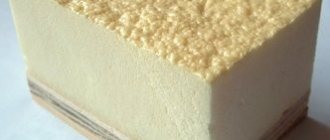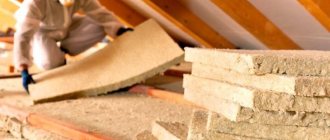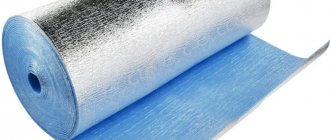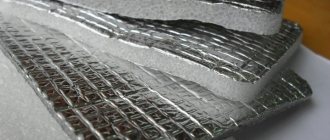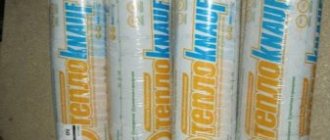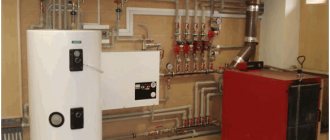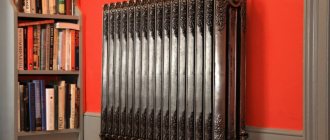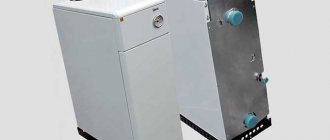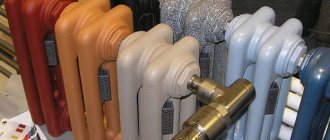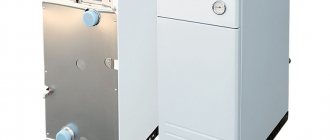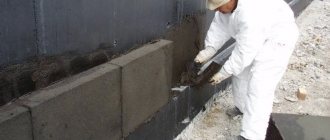Hello, dear readers!
How are you? Are you ready for the cold? Have you warmed up? Today I came across an article that, to put it mildly, puzzled me. It said that this winter would be very vigorous. That is, frosty and snowy. Well, what can we say? There are both advantages and disadvantages to this. The positive aspect is the fun entertainment - sleds, skates, skis, snowballs. And negative - heating the house will cost a pretty penny. In order not to be speechless when looking at the amount on the receipt, it is recommended to insulate the “nest”. Fortunately, there are plenty of materials for insulating a room.
I decided to look at what manufacturing organizations are offering today. My attention was drawn to the “old new” raw material – foam glass. Why "old new"? Well, how can I explain it to you? The old one is 86 years old, and the new one is improved. However, let's study the material in more detail. So, here’s a topic for you - foam glass: disadvantages, advantages, production, cost and much more. Shall we begin? Go!
Cellular glass: product features
A little history
Foam glass was invented by the honored worker of technology and science Isaac Ilyich Kitaygorodsky. The professor specialized in glass production technology, because he considered it the material of the future. The professor's invention was improved by US specialists in the 40s. Initially, foam glass was used as a floating material. But it soon became clear that it demonstrates excellent heat and sound insulation properties, is easily glued together, and is easy to process. Therefore, it was decided to use it in construction.
Thus, in Canada a building appeared, created from concrete slabs with a layer made of cellular glass. This event happened back in 1946. The experiment was very successful. The material has received well-deserved recognition. But, to the great regret of the inventor, it did not gain popularity in Soviet countries, since the cost was high and the production technology had not been developed. It was manufactured in the USSR, but the quality of the product left much to be desired, which led to the closure of factories.
But currently the production of this product is in full swing!
Concept
Balcony insulation
Foam glass is a heat-insulating material made from silicate glass and raw materials that promote gas formation. The insulation is often called foamed or cellular glass because it has a honeycomb-like structure. Due to this, it can boast of unique properties.
Production
Thermal insulation raw material - foam glass - is manufactured using powder technology. The process is quite simple, but labor intensive. It consists of the following steps:
- broken silicate glass is crushed;
- the crumbs are thoroughly mixed with gas-forming substances;
- the charge (homogeneous mass) is placed on a conveyor belt or in molds and sent to the oven;
- the glass softens, turning into a liquid but viscous mixture;
- under the influence of gases the gruel foams;
- the mixture cools slowly;
- the product is formed into blocks, slabs (sheets) or granules;
- the product is processed according to requirements;
- slabs, granules or blocks of foam glass are packaged.
We can say that ordinary glass, which is used in everyday life, and the cellular product are twins, since they are identical in composition, the only difference being the gas-filled pores of the foamed product.
Only high-quality materials and innovative equipment are used to produce blocks, granules or slabs. In addition, the products undergo control, which is carried out by experts in accordance with European quality standards.
Pipe insulation with foam glass material
A typical application of foam glass is pipe insulation. Typically this is a 5 cm thick material with an aluminum foil layer. Used for hot or cold applications ranging from – 230 °
C up to +500
°
C.
Advantages: waterproof, will not lose its insulating properties if it gets wet. If it gets wet, it dries without loss of quality. Foam glass is better for higher temperature pipes compared to fiberglass. More durable than fiberglass.
Disadvantages: very expensive material, labor-intensive work. Cannot be used on pipes subject to vibration, which will turn foam glass into dust.
What is Foamglas foam glass?
Foamglas is a cellular glass insulating material that is impervious to moisture, inert, insect and vermin resistant, strong and reasonably insulating. Foamglas can be used to insulate roofs, walls and as underlays, including under slabs. Its high compressive strength makes it particularly suitable for roof terraces, green roofs and parking areas.
Using Foamglas as external foundation insulation.
Compared to composite thermal insulation materials, Foamglas foam glass is 100% glass, made mainly from sand, limestone and soda ash. The ingredients are melted into molten glass, which is cooled and ground into a fine powder. Powdered glass is poured into molds and heated (below the melting point) and the "sintering" process causes the particles to stick tightly to each other.
A small amount of finely ground carbon black is then added and the material is heated in the same way as in the pulping process. Here carbon reacts with oxygen to create carbon dioxide, which creates the insulating bubbles in Foamglas. In the resulting material, CO2 makes up more than 99% of the gas in the honeycomb of the product.
If you scratch a piece of Foamglas (your fingernail can easily cut it), you will notice a slight rotten egg odor from hydrogen sulfide. Ferrous sulfate is used in the manufacturing process and the process produces small amounts of hydrogen sulfide. You won't have to breathe in much of the hydrogen sulfide since it's tightly locked into the cellular glass - in fact, even after 30 years in a fresh scratch, Foamglas produces the same smell. This is proof that the foam glass chambers are absolutely sealed.
Foamglass
Foamglas foam glass does not contain blowing agents that deplete ozone or contribute to global warming. There are no flame retardants or other additives to improve fire resistance. 100% inorganic Foamglas material is inert and fire resistant.
Foam glass installed for insulation under a concrete slab
The product has sufficient compressive strength for use under any concrete slab - an application currently dominated by extruded polystyrene (XPS). Foam glass is better than XPS because, in addition to being free of chemicals, Foamglas is completely impervious to moisture (water and steam), does not support mold growth, blocks radon, and does not keep termites or rodents inside.
Kinds
Today there are two types of foam glass - granular and block.
In addition, there are three types of granular insulation:
- foam glass gravel;
- foam glass crushed stone;
- foam glass sand.
There are also three types of block insulation:
- slabs (foam glass sheets);
- blocks;
- shells (shaped foam glass).
If we compare the thermal properties of granulated and block glass, of course, gravel, crushed stone and sand are inferior to slabs, shells and blocks. But, nevertheless, granular insulation is more popular due to its relatively low price.
Foam glass insulation
The unique set of properties of foam glass allows this material to be used quite widely: for insulating foundations, basements, floors, frame walls, roofs
[Click on photo to enlarge]
Foam glass is produced in the form of granules and slabs. Granules are a universal fill-in insulation material that has found wide application in insulating floors, walls, and roofs. Blocks are more often used for insulating facades, but can be used as insulation for walls and floors. You can also find broken foam glass on sale - crushed stone. It is cheaper than granules, but absorbs more water.
Insulation with foam glass granules
Granulated foam glass is used in the same way as expanded clay. It is poured between joists, into frame walls, or can be used as a filler for lightweight concrete. Foam glass easily fills all voids. Since it is completely environmentally friendly and safe for health, it does not need to be tightly insulated from the living space like glass wool.
When using granulated foam glass, you need to pour several fractions together - this will improve the thermal conductivity characteristics. If you fill the voids with quartz or perlite sand, the thermal conductivity of the entire insulation layer may suffer.
Scope of application
Foam glass, due to its properties, is used for insulation:
- private houses;
- outbuildings;
- sports complexes;
- underground structures;
- industrial buildings;
- medical institutions;
- educational institutions;
- office facilities;
- recreational facilities - (for example, for baths, water parks, etc.).
The scope of application of the material is very wide, since the thermal insulation material is impeccable:
- to insulate the ceiling: the attic floor is filled with cement-sand mortar, and then the slabs are laid, after which a reinforcing screed is made;
- for walls: the surface is prepared, special glue is applied, the product is applied, pressed tightly and covered with plaster;
- for the floor: a layer of sand (3–5 cm) is poured, thermal insulation is laid or backfilled, joints are sealed, screed is applied, the covering is installed;
Yes, the material is popular due to its good technical characteristics.
Installation of foam glass slabs
The technology for installing foam glass is quite simple.
The slabs are glued with a special glue, and then the wall is lined with decorative material. For gluing blocks, a special two-part bitumen adhesive solution is used, which consists of a liquid and a dry component. The ingredients are mixed before use. For work outside the house, frost-resistant adhesives are used. Foam glass cannot be glued to a cement-sand mixture, because When dry, the solution shrinks and may crack.
It is best to attach blocks to wooden walls using special dowels. This method will ensure air exchange between the log house wall and the insulation, and will also not interfere with the movement of the tree during the period of residual shrinkage.
Surface preparation
- The base is cleaned of dirt and dust; when using glue, it is also very important to remove grease stains that will impair the adhesion of the materials. If there are pockets of mold and mildew, it is necessary to apply antifungal compounds.
- All metal elements must be coated with an anti-corrosion agent.
- The uneven surface must be leveled and then a primer mixture must be applied.
Fastening slabs to walls
- The back side of the insulation is coated with glue, it must be evenly distributed over the entire tile, and the solution is also applied to two side faces.
- In order for the slabs to lie flat, it is necessary to install a horizontal bar (wooden or metal) below at the level of the plinth.
- The slabs are laid in the direction from bottom to top. The first row is mounted on a support rail, which is removed after installation work is completed.
- The blocks of the second and subsequent rows are installed offset, so that the joining seams of the tiles of adjacent rows do not coincide.
- After the glue has dried, the tiles are additionally fixed with dowels.
When thermally insulating the walls of a log house, the slabs are laid in the same way, but without the use of glue.
Subsequent layers of the insulating cake depend on the type of decorative finish:
- If the wall is to be covered with decorative plaster, a reinforcing mesh is laid on top of the slabs;
- Before facing the wall with stone or other material that creates a large load, each tile must be additionally strengthened with 4-5 dowels, and a frame made of wooden slats or a metal profile must be installed on top.
- When constructing a brick wall, there must be an empty cavity at least 25mm wide between the insulation and the masonry.
- When finishing walls with clapboards, panels or siding, the frame method of fastening the sheathing is also used.
Floor insulation
Thermal insulation of the floor can be done with either tile or bulk insulation.
Insulation with foam glass blocks is performed as follows:
- Foam glass slabs are laid on top of the concrete base, they can also be laid directly on top of compacted sand.
- The next layer is waterproofing. To do this, you can use PVC film laid in two layers.
- The entire insulating structure is filled with cement screed. Any floor covering can be laid on top.
Stages of floor insulation along joists using granular filling:
- Wooden blocks are placed under the logs, on which boards are laid.
- The space between the ceilings is filled with foam glass granules.
- The top of the insulation is covered with a layer of vapor barrier.
- Lay the subfloor.
- Lay any floor covering.
Properties
Cellular glass is famous for the following properties:
- noise absorption – 56 dB;
- water absorption – 0–5%;
- vapor permeability – 0–0.005 mg/m*h*PA;
- thermal conductivity – 0.04–0.08 W/(m*K);
- humidity (sorption) – 0.2–0.5%;
- bending strength – 0.4–0.6 MPa;
- compressive strength – 0.7–4 MPa;
- effective operating temperature – -260 – +400°С;
- actual operating temperature – -260 – +230°С;
- deformation temperature – +450°С.
Based on this data, recognized advantages and annoying disadvantages can be determined.
Advantages
The material has many advantages. Let's look at the main ones.
- Safety. Does not contain substances harmful to the human body.
- Environmentally friendly. Made from environmentally friendly raw materials.
- Hygiene. Has antiseptic properties.
- Durability. Service life - more than 100 years.
- Versatility. It is used for insulation of any buildings.
- High adhesion. Combines with a lot of building materials.
- Biological passivity. He is not afraid of rodents, insects and microorganisms.
- Resistance to the negative effects of climatic factors. He is not afraid of temperature changes, precipitation, UV, etc.
- Resistance to mechanical factors. It does not deform and does not lose its properties, since it can withstand impacts and high loads.
- Unaffected by chemical factors. Does not react to acid.
- Resistance to thermal factors. Foam glass is an absolutely non-flammable insulation material.
- Ease of processing. It cuts perfectly with a regular hacksaw.
The material is worthwhile, but there are drawbacks and there are many of them, unfortunately.
roof insulation with foam glass
What it is?
Penoizol is a modified polystyrene foam. Its consistency resembles marshmallow. The material is foamed plastic with a cellular structure. Modified polystyrene foam is a modern heat insulator for insulating building structures.
Often the material is prepared directly on the construction site. Using specialized equipment, the liquid mixture is used to fill voids in walls, ceilings, roofs and attics. Thanks to the production of insulation at a construction site, money, time and effort are saved on the delivery of conventional insulation and its loading and unloading operations. No additional space is required for storing thermal insulation products.
Flaws
Of course, every raw material has its negative aspects. Foam glass is no exception. Before purchasing material, you need to carefully study the negative aspects.
- High price. The production of raw materials requires innovative high-tech equipment, which leads to its rise in price. And also the production of foam glass requires high energy costs.
- Fragility. The raw material, despite its strength, is very fragile, which leads to cracking if installation recommendations are ignored.
- Lack of steam conductivity. Foam glass, as was said, is not subject to the destructive effects of biological factors, but the surface under it is easily damaged.
- Fear of alkalis and hydrofluoric acid. Cellular glass, like an aspen leaf, trembles at the “sight” of alkalis and hydrofluoric acid, since they are capable of destroying it.
- Heaviness. The raw materials are relatively heavy, which negatively affects the building structure.
- Durability. Of course, a long service life is a plus. But the materials used to construct the facility are unlikely to last more than 100 years. This means that the structure must be repaired periodically, and cellular glass is not intended to be reused. Which exit? Replacing insulation.
- Low impact strength. Cellular glass does not withstand even light impacts. Mechanical influence is the “death” of the material. Of course, if the insulation is in the structure, it is not afraid of impacts. He is afraid of them during transportation, unloading and installation.
- Impossibility of “reanimation”. If the glass is damaged, it can be taken to a landfill. It is impossible to glue or cover up the cracks.
Properties played a cruel joke on cellular glass, turning a huge number of advantages into disadvantages.
How is foam glass produced?
Broken glass and recyclable materials are ground with a blowing agent (coal, coke, soot, anthracite) and poured into molds, mixed with other additives. The mold is filled approximately 10%; the entire volume will be filled during the formation of glass foam. Firing takes place in a tunnel kiln at a temperature of about 1000°C. During the glass melting process, the blowing agent increases the mass by 14-15 times and the mold is filled.
Foam glass production line of a German plant
For foam glass granules, the technology is different: the cullet is washed and dried, crushed, then ground with foaming agents and the charge is granulated. Next, the granules are dried and placed in rotating kilns, where the granules are sprinkled with quartz sand to prevent soldering. Foaming takes place at temperatures from 780 to 820°C.
The cost of foam glass is very high due to the energy intensity of production and expensive equipment (equipment for a line for 20 m3 per day costs about $1 million).
Types of foam glass:
- Blocks (slabs)
- Granules
- Shapeless battle (construction rubble).
Advantages of foam glass
- Very long service life. This material can last about 100 years, which is indicated in its characteristics. So far, such a long period has not been recorded, if only because so much has not passed since the day of its invention.
- Lack of oxidation due to the presence of oxides such as silicon oxide, sodium oxide, calcium oxide, magnesium oxide, aluminum oxide.
- It is not subject to erosion, since the composition does not contain substances washed out by water.
- No exposure to temperature changes. Withstands any temperature changes in any climate zone and at any time of the day or night.
- Does not deform as a result of mechanical stress.
- Since the material does not contain biological compounds, it is not exposed to fungus, mold and microorganisms.
- High strength. Unlike heat-insulating materials such as polystyrene foam, the strength of foam glass is several times higher. Due to its strength, it does not require additional fastenings during installation.
- Constancy of size. The cells that make up the block do not allow it to change under the influence of any factors. Not only the geometry of the block does not change, but also the thermal insulation properties. This means that according to its characteristics, the material of the blocks is close to concrete or brick.
- Consistency over time. Strength, thermal conductivity, geometry - all this has not changed for at least 50 years. The primary parameters were preserved as if not so many years had passed.
- Resistance to chemical and biological influences. Glass, as you know, is not exposed to chemicals. It is not needed by harmful bacteria or fungi. This is very suitable for unventilated areas (basement, roof top, storage areas). Serves as an excellent barrier to pests in places such as industrial refrigerators and vegetable and grain storage areas.
- Non-flammable material. Glass is melted in furnaces at a temperature of about 1000 degrees Celsius. In the event of a fire and reaching such a temperature, it will also only melt without releasing any harmful substances.
- Moisture resistance. Glass does not allow water to pass through in any direction. When finishing walls, this moment is convenient in terms of creating an additional water barrier.
- Sanitary safety. The cells have microholes through which the material “breathes.” This creates a certain indoor microclimate and air purity. Creating environmental cleanliness and sanitary safety is an important point in public buildings.
- Noise insulation. Having a number of positive aspects, foam glass also has good sound insulation.
Disadvantages of the material
The disadvantages of foam glass may be precisely what may prevent its use in a particular case. The choice of material according to its main parameters also characterizes the attitude towards it.
This is especially important if the slightest characteristic can push us away from the insulation already chosen, for example. Such points may be thermal conductivity, moisture conductivity, environmental characteristics, sanitary safety.
Here are the disadvantages of foam glass:
- Despite its long life, the material has a high production cost. Production requires modern high-tech equipment, which leads to its rise in price. Other insulation materials are inferior to it in some ways, but they are much better in price.
- The material is very fragile and the slightest deviation from the recommendations for working with it leads to cracking.
- Unlike modern materials, there is no vapor conductivity. And if the material itself is not susceptible to fungus and mold, then the wall may become infected.
- It is unlikely that hydrofluoric acid or alkalis will come into contact with the material, but nevertheless this is what he is afraid of.
- Not subject to tension or compression can lead to cracking during movement of other components of the structure (walls, ceilings, floors).
- No matter how foamed the glass is, it is still glass, which means the blocks are quite heavy. The weight of the blocks greatly affects the entire structure of the construction site. Therefore, it is necessary to calculate the loads on supporting structures in advance and very carefully.
- The material of the blocks does not withstand shock loads at all. If, for example, the block was cracked and then joined together during installation using cement mortar, this will not save it from exposure to moisture. In fact, it becomes unsuitable as insulation.
- Greater durability also serves a disservice in this case. The material itself may last a long time, but the materials from which the building is constructed may not last. When making repairs or dismantling a building, it will be difficult to keep blocks of this type of insulation intact. That is, durability in this case is a big and expensive problem.
Price
The cost of foam glass is steep. Prices, of course, vary, as they depend on many factors, but on average you can buy blocks by paying $120–400 per cubic meter. You can purchase slabs and shells by paying $110–350, and you can get a granular version by spending $35–100 per cubic meter.
What can we say? Insulation with foam glass is a very dubious and costly undertaking, since the material has a lot of serious drawbacks, and, in addition, is incredibly expensive. But, as they say, the master is the master. Maybe it’s not for nothing that they call it the raw material of the future. To buy or not to buy? That is the question! The choice is yours, dear readers.
Warmth and comfort to your home, dear friends! See you on other blog pages!
Wisdom quote: Reading is the best teaching (A.S. Pushkin).
Criterias of choice
First of all, you need to choose based on the thickness of the slab. This is about 12 cm for external insulation and 6 cm for internal insulation. A smaller thickness can be chosen for insulating houses in the south and coastal areas. We should also talk about the choice of block dimensions. As a rule, blocks of standard sizes are sold, but with the help of a regular hacksaw they can be cut to smaller sizes.
Why do this? First of all, in order to solve the problem of ventilation of the structural layer of the enclosing structure. The more seams are made, the more places there will be for steam to escape and, therefore, ventilation of the rough surface of the wall.
The question arises how much this will worsen the thermal insulation properties. But the beauty is that there will be no deterioration in the thermal insulation properties.
The adhesive has protective properties similar to insulation. However, you shouldn’t get carried away with reducing the block either. A reduction of 2-4 times is sufficient. Excessively small blocks mean an even greater reduction in the strength of the insulation.
